Hyundai speaks fluently with new Accent
By John Gilbert
LAS VEGAS, Nev. — The latest new Hyundai appears certain to be a major sales success — with apologies to all if that sounds redundant.
The hits just keep on coming for Hyundai, and the 2012 subcompact Accent is just the latest offering to use up whatever superlatives remain. It is stylishly designed both as a sleeker sedan or the cargo-happier 5-door hatchback; it is lighter but stronger and therefore safer; it is peppy and fun to drive but extremely frugal, at over 40 miles per gallon; it goes better than most subcompacts because it’s the only one offering 6-speed transmissions in either stick or automatic; it stops far shorter than any other subcompact because it’s the only one with 4-wheel disc brakes; and it has enough interior room to qualify as a compact rather than subcompact by EPA rules.
And, oh yes, it can be bought for a base price of $12,445.
Although the base GLS sedan is surprisingly well equipped, you can jack up the price with all sorts of options and features you may not expect in a subcompact, all the way up to a loaded SE 5-door at $16,795. The sticker price, economy, content, and fun quotient — especially the 40 mpg and the sticker price — may make the Accent most deserving of accolades, even in Hyundai’s stable of over-achieving prize-winners.
It doesn’t matter what Hyundai does to expand its impressive portfolio of high-tech yet budget-friendly automobiles, every time there’s a model changeover, the South Korean company simply strikes again to raise the bar. If an analogy helps, think about watching 23-year-old Irishman Rory McIlroy play golf in the 2011U.S. Open: Every hole he played, he hit a near-perfect shot with great length, down the middle, then hit it up next to the hole, then sank the put for a birdie, or a par, but almost devoid of anything approaching a bogey. The next day, he did it again, shooting all four rounds with under-par scores in the 60s to completely outdistance the rest of the field of the best golfers in the world. McIlroy came out of nowhere to look like he might be the best golfer in the world, Tiger Whatsisname notwithstanding. In the automotive world, Hyundai is doing the same thing.
Two years ago, Hyundai introduced its Genesis luxury sedan, which captured the 2010 North American Car of the Year award, adding fame when its new 4.6-liter V8 was named to the select annual list of Ward’s top 10 engines of the world. Impressive, but as the Genesis smoothly crooned out classics, it was promptly upstaged when Hyundai turned the Sonata into an automotive rock star. The 2011 Sonata midsize sedan has it all, with solid build-quality from its new Montgomery, Ala., plant to go with flashy California design contours, a direct-injection upgrade to its 2.4-liter 4-cylinder engine, for the best power and fuel efficiency in its class, and a superb new Hyundai-built 6-speed automatic transmission — all for a bargain price. The American buying public took immediate notice, and In May of 2011, Sonata was the No. 1 car sold in the U.S., trailing only the perennial leading Ford F150 and Chevrolet Silverado pickup trucks.
When the Tucson compact SUV was renovated, nobody was surprised that it, too, was a major success from both design and performance standpoints, and it will become even better when the GDI version of its 2.4 is installed for the 2012 model year. Next came the new Elantra compact, which is sort of a downsized Sonata in styling, and hits a legitimate, real-world 40 miles per gallon from its new 1.8-liter “Nu” engine, while rising above the fierce competition by offering both a 6-speed manual and the slick 6-speed automatic. Hyundai officials point out that competitive makes that advertise 40 mpg charge extra for special effects to attain it, requiring the use of asterisks to disclose that all models don’t reach 40, while the Elantra achieves 40 with all models, stick or automatic. Hyundai also measured its competition and divulged statistics showing that all the other 40-mpg competitors combined sold 15,000 for January through May of 2011, a span when Hyundai sold 80,000 Elantras.
What could Hyundai have left to prove? If you must ask, make sure to speak with a distinct Accent.
The Accent has been a nice little bargain econocar, since before Hyundai’s meteoric surge upward in the last two years. As if to celebrate all the impressive and expensive tricks used in the other categories, Hyundai combined all of them to make sure the new Accent would jump to the head of its class. Such cars as the Toyota Yaris, Honda Fit, Ford Fiesta, Nissan Versa, Mazda2, and Chevrolet Sonic reside there, an affordable group with good mileage, which makes it logical that consumers are boosting subcompact segment projections upward by 33 percent this year. With fuel economy flirting with $4 per gallon, the majority of consumers now claim that fuel economy is No. 1 among criteria for selecting a subcompact.
Hyundai is perfectly positioning the Accent for that reality. After proving the value of direct injection with the Sonata, they were satisfied that the Elantra could reach 40 mpg without the costly direct-injection method of sending a totally-combustible mist into each cylinder. So the Elantra doesn’t use GDI (gas direct injection), but Hyundai took no chances with the Accent. It switched from a cast iron to an all-aluminum 1.6-liter Gamma engine, with gas direct injection, saving 40 pounds and increasing power by 25 percent. Building the new car with high-grade steel was another breakthrough. There are various grades of steel, and since Hyundai is the only auto company that owns its own steel plant, it has ready access. With high-grade steel, a manufacturer can make body panels and structural pillars thinner and yet stronger — and safer – compared to the same size car built of thicker but lower grade steel. The Accent uses 38 percent high-tensile steel, which is impressive; it also uses an additional 21 percent ultra-high grade steel. Those two high-grade levels total of 59 percent of the car, allowing the Accent’s body stiffness to improve by 22 percent over its predecessor, improving its safety characteristics significantly.
The Accent weighs 2,396 pounds as a 4-door sedan, and 2,430 in 5-door hatchback form, so the lighter 1.6 GDI Gamma engine’s 138 horsepower at 6,300 RPMs, and 123 foot-pounds of torque at 4,850 RPMs, are easily sufficient. Those 138/123 horsepower/torque figures compare with the Fiesta’s 120/112; the Mazda2’s 120/98; the 108/105 of the Chevy Aveo; 106/103 of the Yaris; 117/106 with the Fit; and 109/107 with the Versa.
Of all those competitors, only the Fiesta offers a 6-speed automatic, and none offers a manual with anything other than a 5-speed, making the Accent stand alone with the choice of a 6-speeds in either the stick or the impressive Hyundai-built automatic, with Shiftronic manual-shift mode. Figuring pounds per horsepower, the Fit is the best of the competitors, with 21.3 pounds per horsepower, while the Accent has a decisive edge with17.6 pounds per horsepower in the 5-door and 17.4 with the slightly lighter 4-door sedan.
The new Accent has an “Active Eco” switch that modifies engine and transmission control for up to 7 percent fuel economy improvement. The concerted focus — you should pardon the expression — attains a 40 mpg highway mileage rating that is an 18-percent improvement over the outgoing model’s very good 34 mpg. To reach it, the Accent combines the lighter engine for a 6.1 percent mileage improvement, electric steering for a 4.1 percent increase, an improved altenator management system for 2.7 percent, low rolling resistance silica tires for 2.1 percent, dropping the aerodynamic coefficient of drag from 0.31 to 0.30 for 2.1 percent, and using a 6-speed manual compared to the outgoing 5-speed for 1.0 percent. That adds up precisely to 18.1 percent.
In our preliminary test drive, we got well over the EPA’s 40 mpg, too. I was curious about Hyundai choosing to not put direct injection on the Elantra engine, but making sure to use it on the smaller Accent. Mike O’Brien, the chief engineer on the car, explained how the new aluminum engine has dual variable valve-timing, with a maintenance-free timing chain, and an offset crankshaft to nullify vibration, and electronic throttle control — all worthy upgrades for any engine. “But direct injection is the single biggest improvement possible to affect the fuel economy of a gasoline engine,” he said. “It all comes down to the detonation of fuel, and with direct injection we’re able to raise the compression ratio while keeping the fuel cool, improving the volumetric efficiency.
“The biggest challenge for us is that direct injection is comparatively costly, and we have to weight the obvious advantages against the cost. We decided to do it because we expect we could manage the cost, with component costs coming down.”
When we got the chance to drive the Accents out of Las Vegas and down to Hoover Dam, then back up through the surrounding hills to Loew’s resort, I picked out an SE model with a stick, to get the taste of the sportiest version. My codriver noticed how free of wind-noise the Accent was, and how comfortable the clutch engagement was. I drove later, and agreed completely, and I had the chance to drive much more aggressively on some curvier roads to higher elevation.
After such aggressive driving, I was impressed that the computer showed I had attained 39.5 miles per gallon, until my codriver informed me she had gotten 47.5 mpg. The Accent SE’s EPA estimates are for 30 city and 40 highway, so my 39.5 was right on it, impressive for how hard I drove, but her 47.5 proved that with only a bit mellower driving, the Accent would follow the normal Hyundai habit of exceeding its EPA figures with real-world facts. We can attribute the over-achieving to Hyundai’s GDI.
The roominess inside the Accent is created by optimum use of the slight enlargement, which is 3.5 inches longer with a 2.8 inch lengthening of the wheelbase. The 5-door hatchback cargo capacity measures 21.2 cubic feet, which ismore than larger-class vehicles such as the Infiniti EX35, Audi A3, Mazda3 5-door, or Subaru Impreza 5-door.
Styling of the Accent takes on the current Hyundai signature look of “fluidic sculpture,” featuring flowing lines that seem to be in motion even while parked. I like the sleekness of the sedan, but the hatchback has a sporty flair, especially with the little rear spoiler atop the hatch on the sportiest SE model. The interior layout is roomy, with a neatly arranged instrument panel and center console that house all the switchwork and gauges in placement that works for both ergonomic and aesthetic success. The seats are well-bolstered and comfortable, and the interior comes in a choice of beige, grey, or black. The lining of the interior strikes a new balance between the soft spongy stuff that beats the old hard and harsh plastic, by combining plastic, fibrous tissue, and volcanic rock. I never got the chance to ask a Hyundai executive about where, why and how volcanic rock worked its way into the equation.
The GLS, GS, and SE all are different, but Hyundai wisely limits the Accent to eight different orderable configurations. Others offer many more combinations, but Hyundai explained that having too many means customers have difficulty finding exactly what they want at dealerships. We later drove other models, to make sure the strong 6-speed automatic performed well, too. It didn’t seem much of a letdown, even though the SE has a sport-tuned suspension. Features, such as hill-start assist and electronic stability control, are obvious assets, as are the 4-wheel disc brakes, which stop the Accent with proper urgency.
Hyundai projects that the 5-door hatches and the 4-door sedans should split sales about 50-50, while stick-shift versions should account for 20 percent of Accent sales.
The SE we first drove had the model’s extended list of standard features, with electronic stability control, traction control, antilock brakes with electronic distribution and assist, air-filtration on the air conditioning, steering wheel remote controls, Bluetooth phone connectivity, power windows, mirrors and locks, keyless entry, trip computer, foglights, rear wiper, and seatbelt pretensioners as well as tire pressure monitoring, AM-FM-MP3-iPod audio with six speakers and satellite radio, and 16-inch alloy wheels. The base price for all that was $15,795, and it went up to $15,925 only after adding carpeted floormats and a cable for iPod use.
Comments
One Comment on Hyundai speaks fluently with new Accent
-
quest bars on
Thu, 18th Feb 2016 8:37 pm
Saved as a favorite, I love your website!
Tell me what you're thinking...
and oh, if you want a pic to show with your comment, go get a gravatar!


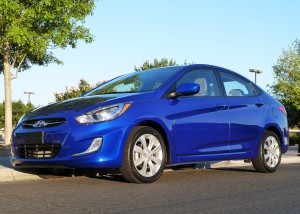
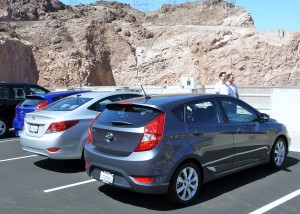
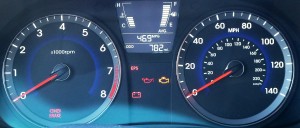
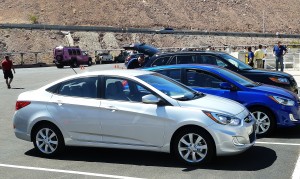
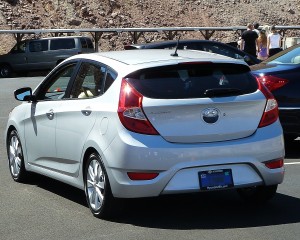
 John Gilbert is a lifetime Minnesotan and career journalist, specializing in cars and sports during and since spending 30 years at the Minneapolis Tribune, now the Star Tribune. More recently, he has continued translating the high-tech world of autos and sharing his passionate insights as a freelance writer/photographer/broadcaster. A member of the prestigious North American Car and Truck of the Year jury since 1993. John can be heard Monday-Friday from 9-11am on 610 KDAL(www.kdal610.com) on the "John Gilbert Show," and writes a column in the Duluth Reader.
John Gilbert is a lifetime Minnesotan and career journalist, specializing in cars and sports during and since spending 30 years at the Minneapolis Tribune, now the Star Tribune. More recently, he has continued translating the high-tech world of autos and sharing his passionate insights as a freelance writer/photographer/broadcaster. A member of the prestigious North American Car and Truck of the Year jury since 1993. John can be heard Monday-Friday from 9-11am on 610 KDAL(www.kdal610.com) on the "John Gilbert Show," and writes a column in the Duluth Reader.